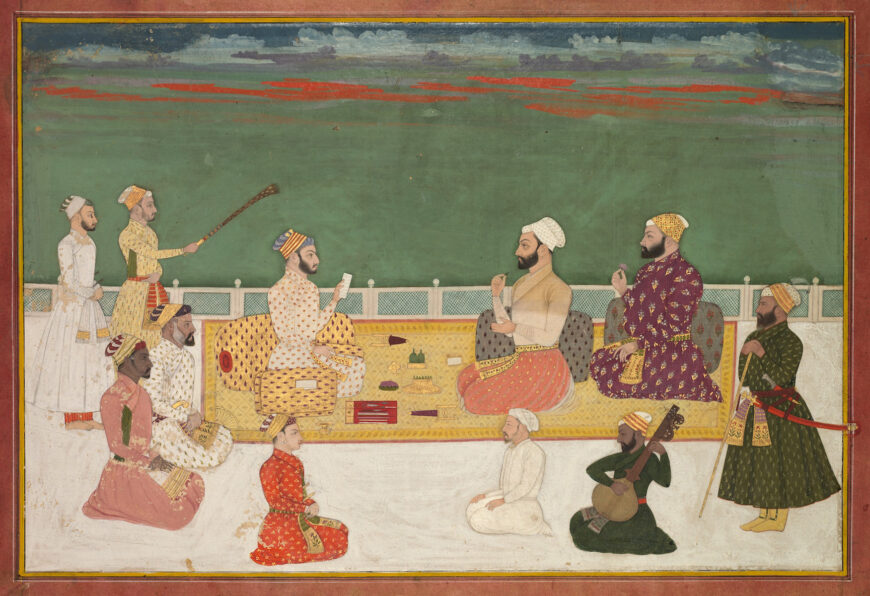
A Ruler Presents a Document to Visiting Nobles, c. 1700–20 (southern India), opaque watercolor and gold on paper, 22 x 32.7 cm (The Cleveland Museum of Art)
South Asian textiles are distinguished by their versatility—the same length of cloth that is worn as a sari can just as easily be used in other capacities. With few limits to their utility, textiles are found everywhere, from living spaces to personal wardrobes, from kitchens to sacred altars. Let’s explore a few ways in which textiles are used beyond clothing, particularly as additions to living spaces, household and personal objects, and adornments and accessories for animals.
Spaces
Textiles have always been a part of living spaces. When furniture made of wood or other solid materials had yet to become staple, textiles organically fulfilled the role of furniture in the architectural history of the subcontinent. From warming floors and providing added privacy to serving as seats or storage, textiles of all types have been used in a multitude of ways.
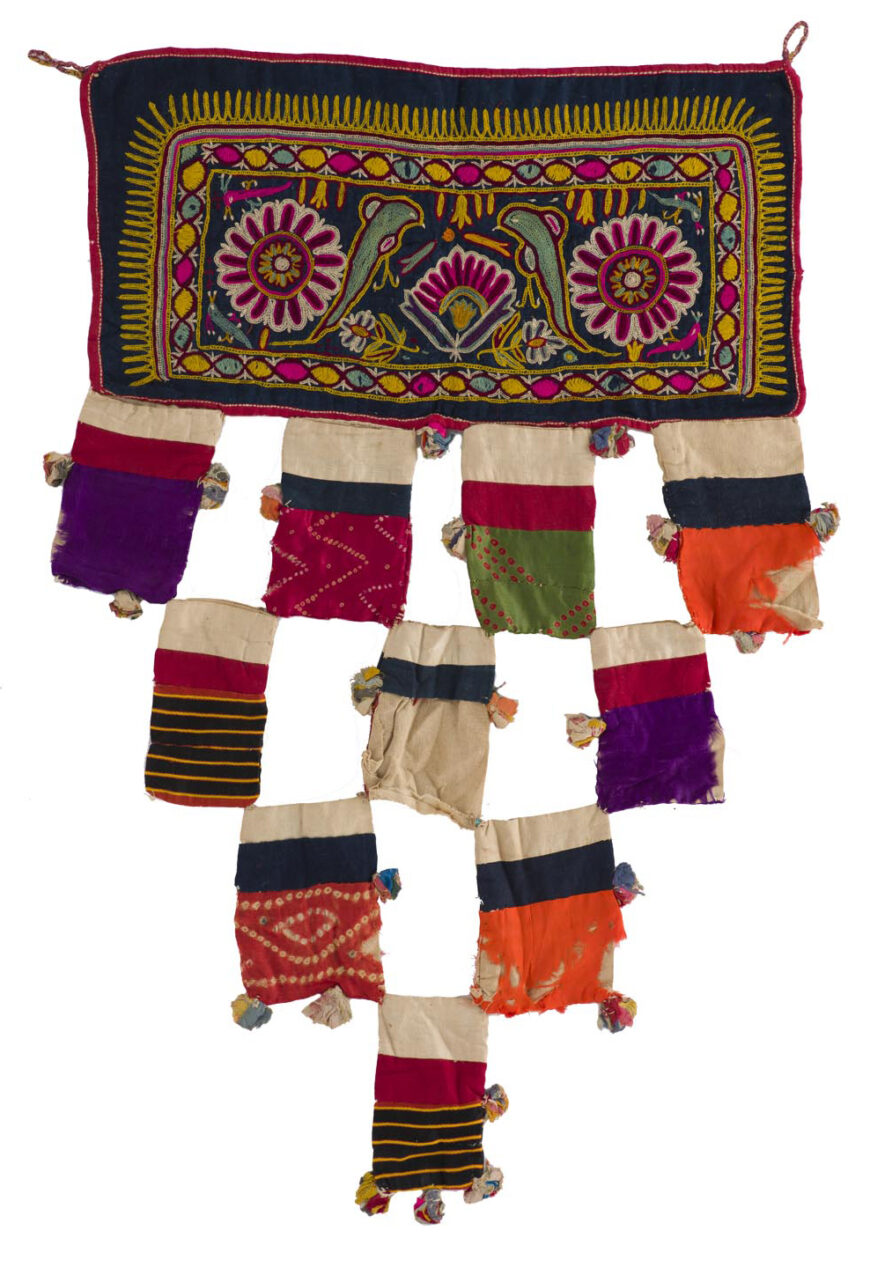
Embroidered Toran, 20th century (Gujarat, India), cotton, silk, 22.5 x 47 cm (Museum of Art and Photography, Bengaluru)
Interior furnishing and accessories
One of the most important uses of textiles in the home is in the form of soft furnishings. Block-printed cotton textiles such as Ajrakh and Sanganeri are commonly used as bed sheets, pillow covers, mattress covers, and curtains to enrich living spaces. Block-printed fabrics are also used to make Rajasthani dohars—specially crafted, multi-layered muslin quilts that are known for being lightweight yet warm, making them ideal for desert climates. Cushions and bolsters made from embroidered textiles and brocades add a touch of decoration while also functioning as forms of seating.
We also see textiles take on decorative functions as accessories that brighten the walls of spaces. Wall hangings such as Chaklas and doorway hangings such as Torans or Bandhanwars, made of brocades and embroidered textiles, add color to homes in Gujarat and Rajasthan where they are popularly used. Some textiles that feature religious imagery or symbolism simultaneously serve aesthetic and ritual functions in sacred spaces such as shrines, temples, and prayer rooms.
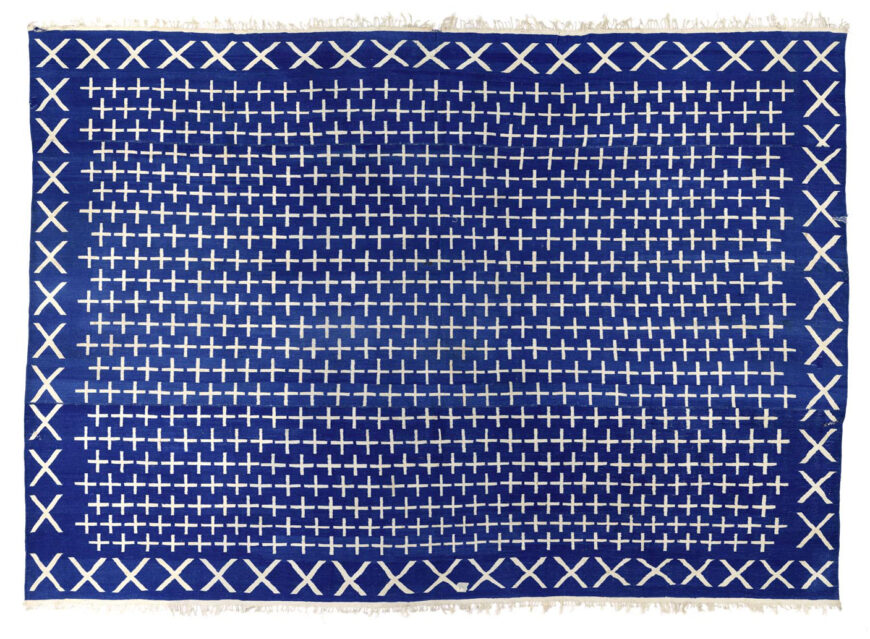
Dhurrie, 20th century (Rajasthan, India), cotton, 414 x 303 cm (Museum of Art and Photography, Bengaluru)
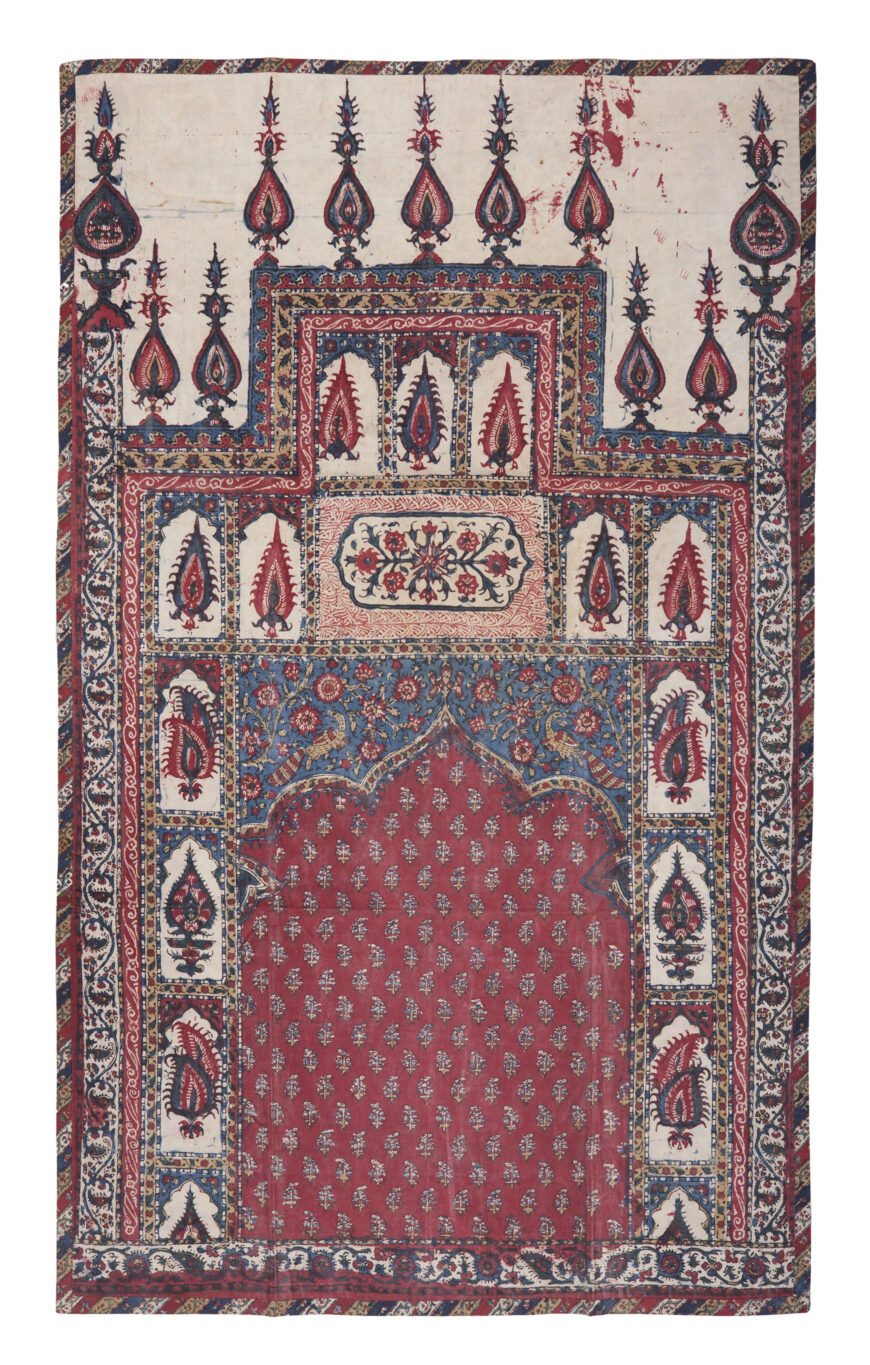
Kalamkari prayer mat, late 19th century (Machilipatnam, Andhra Pradesh for Iranian market), cotton and natural dyes, 59 x 36 cm (Museum of Art and Photography, Bengaluru)
Floor coverings
Floor coverings such as dhurries, carpets, rugs, and mats or asanas can be found all across the Indian subcontinent. Made with different materials and techniques, these textiles can be luxurious with intricate designs and complex weaves, such as the elaborate carpets that were used in royal courts, but they can also be simple. Cotton dhurries are ancient textiles that have been woven in the subcontinent for centuries. These floor spreads can be plain or patterned, with stripes and bold geometric forms in varying colors. Some floor coverings even have specialized functions, such as the Islamic prayer rugs or janamaz, known for their iconic mihrab design, resembling the arch in a mosque that is meant to point towards Mecca, a significant religious site for Muslims around the world.
People
Beyond costumes and accessories, people commonly use objects made of textiles in their daily lives. These personal objects are often part of important events such as births, deaths, and weddings. They also serve as functional articles within the bathroom and kitchen.
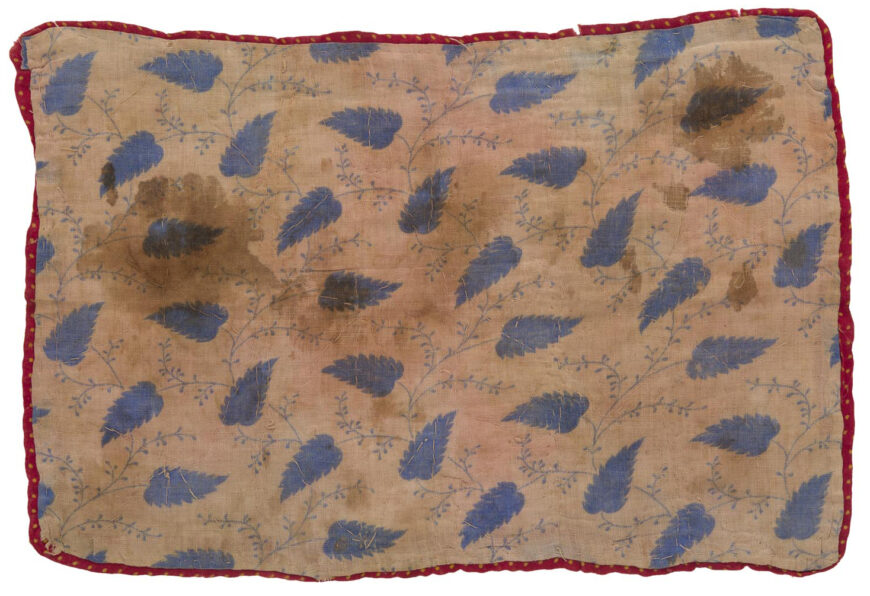
Printed household textile, 20th century (Gujarat/Rajasthan, India), cotton, 37.5 x 25.5 cm (Museum of Art and Photography, Bengaluru)
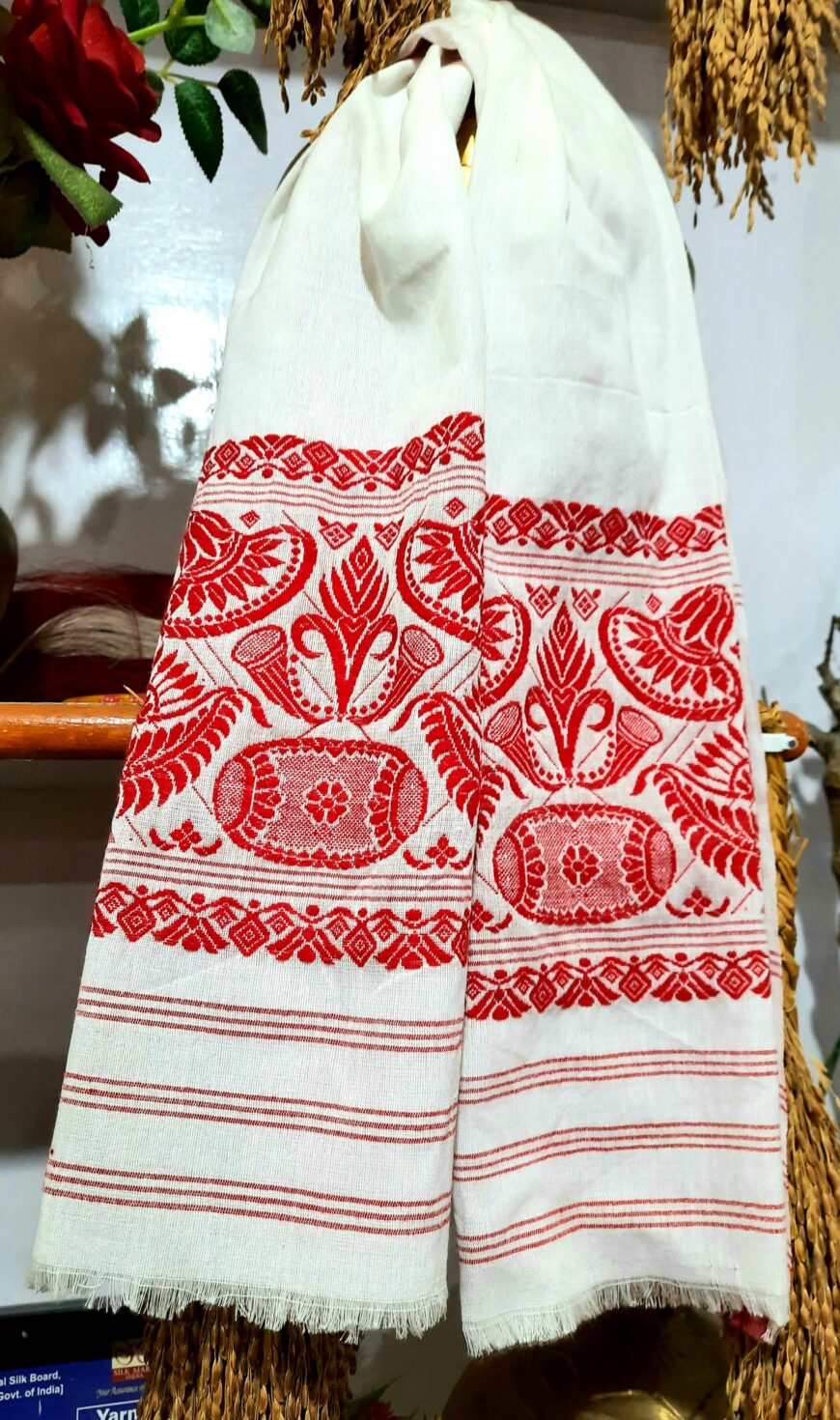
Gamcha, Lakhimpur, India (photo: Rumi Borah~aswiki, CC BY-SA 4.0)
Towels and household textiles
The gamcha, also known as gamocha or gamusa, is a specially woven cotton towel widely used for drying the body in Assam, Orissa, and West Bengal. In several regions, men also tend to wear this textile around their necks as part of their daily attire, for wiping sweat. In Assam, gamusas are considered important cultural symbols and are also given to guests as ceremonial gifts. Typically woven in white cotton with red patterned borders, these textiles are also used in religious contexts.
Textiles are often cut into pieces and used for miscellaneous functions around the house. Scraps of printed and plain cotton textiles are commonly repurposed and reused as kitchen towels, coasters, padding for hot vessels, and so on. Sometimes, special household objects such as hand fans and potholders are also made of highly embellished textiles.
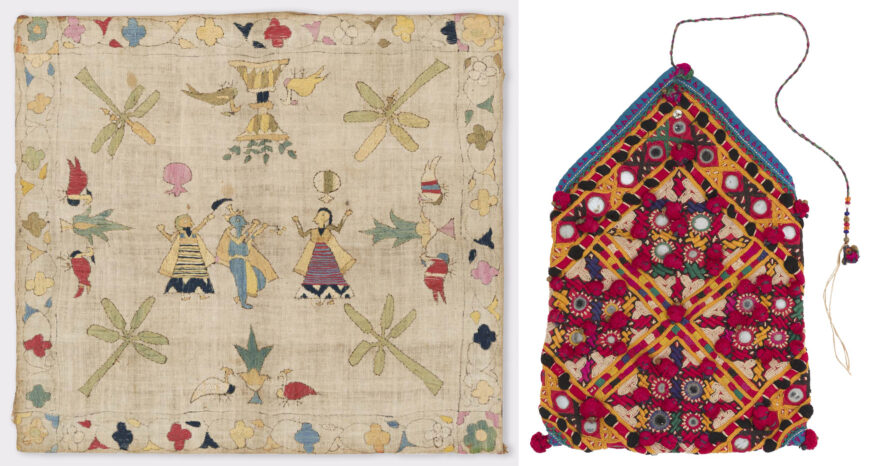
Left: Pahari Rumal, 19th century (Himachal Pradesh, India), cotton, floss silk, 48 x 52 cm (Museum of Art and Photography, Bengaluru); right: Embroidered Kothalo (dowry bag), 20th century (Gujarat, India and Sindh, Pakistan), cotton, mirrors, sequins, and glass, 21.5 x 15 cm (Museum of Art and Photography, Bengaluru)
Trousseau items
Handcrafted textiles often play important roles in wedding traditions across the country. Historically, textiles like Chamba Rumals have been specially embroidered by women as part of their dowry. Often portraying rich narratives inspired by Pahari miniature paintings and stories from the life of Krishna, these rumals or handkerchiefs are works of art in themselves.
Embroidered textile bags are also considered important trousseau items across the country. In certain communities in western India, it was common practice for women to make dowry bags in preparation for their wedding. There are different types of such cloth bags, which often have their own associated traditions. Some types of dowry bags are embroidered with silver and gold thread, providing additional financial security for tough times.
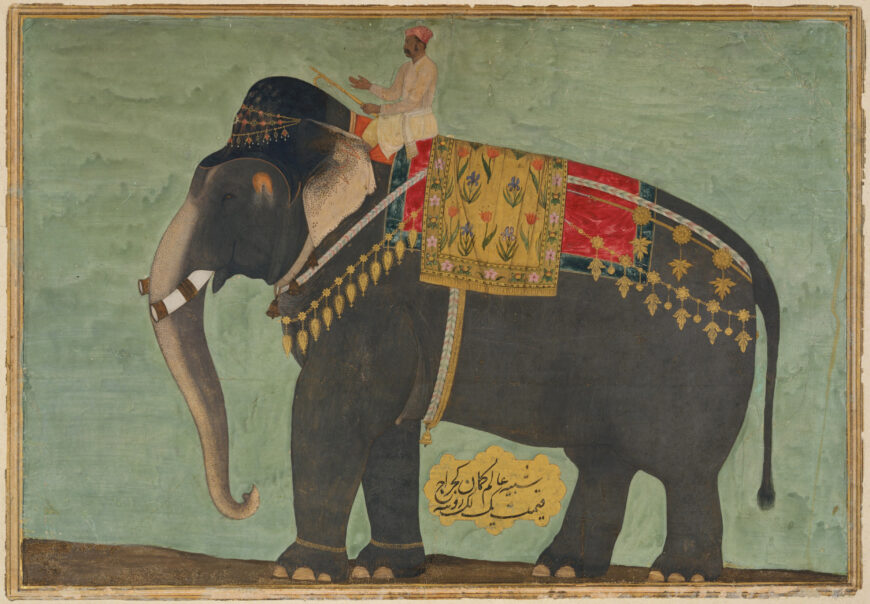
Portrait of elephant gifted to Emperor Jahangir. Attributed to Bichitr, Portrait of the Elephant ‘Alam Guman, c. 1640 (India), opaque watercolor and gold on paper, 46 x 32 cm (The Metropolitan Museum of Art, New York)
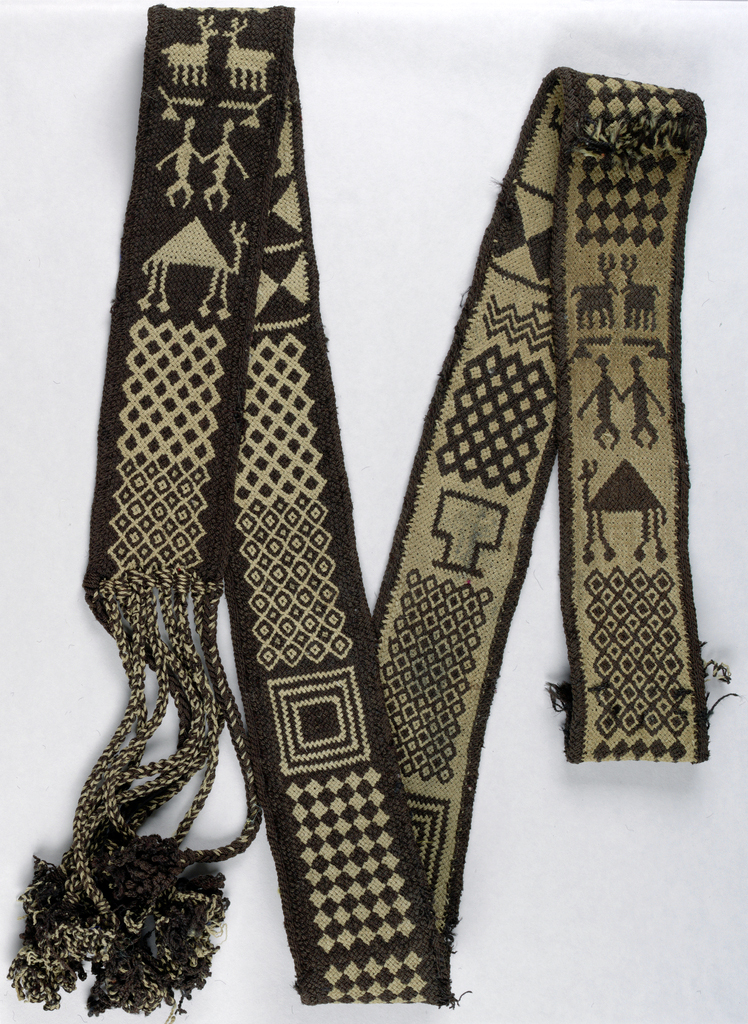
Camel girth, early–mid-20th century (Pakistan), goat hair, 269.2 x 9.5 cm (Cooper Hewitt, Smithsonian Design Museum, New York)
Animals
The use of textiles also includes functional and decorative pieces that have been specially crafted for animals. Camel girths made in the desert region of Rajasthan are simple braided belts that are used to keep the saddle in place. One of the simplest textiles produced in the country, these belts are woven by hand out of cotton cord and goat hair, without the use of looms.
It was also a common practice in the country, historically, to bedeck animals with highly decorated textiles—such as trappings and saddle cloths that were both aesthetically pleasing and functional—for religious and courtly ceremonies. In the miniature painting from the 17th century, we see an elephant gifted to the Mughal Emperor Jahangir strapped with a richly decorated saddle cloth with floral designs. Elephants were greatly treasured in the Mughal court and the opulence of the textile depicted in the painting illustrates the value assigned to the animal as well as the wealth of the emperor. There are also many examples of decorative bags that are used to transport objects on the backs of animals.
The multiple functions of textiles are a testament to the omnipresence of cloth in everyday life in the Indian subcontinent. These fabrics take on a variety of purposes, highlighting the flexibility and the indispensability of textiles. It is common practice for fabrics to be repurposed many times before they are discarded. Across the region, old textiles are often remade into quilts for daily use, as we can see in many traditions such as the Kantha quilts of Bengal, the Godhari quilts of Maharashtra, and the Siddi quilts in Karnataka. Even humble cotton rags meant for mopping floors are crucial in homes and illustrate the central role that textiles play in people’s daily lives.
Additional resources
Take a short course on Textiles from the Indian Subcontinent with The MAP Academy
Rosemary Crill, editor, Fabric of India (London: Victoria and Albert Museum, 2015).
Judy Frater, “Embroidery: A Woman’s History of Kutch,” Indian Horizons, volume 63, number 2 (2016), pp. 22–35.
Ruchira Ghose, Mapping Indian Textiles: Approaches to Display and Storage of Indian Textiles in Public Museums (New Delhi: Indira Gandhi National Centre for the Arts, 2017).
John Gillow and Nicholas Barnard, Traditional Indian Textiles (New York: Thames and Hudson, 1991).
Aditi Ranjan and M. P. Ranjan, editors, Handmade in India: Crafts of India (New Delhi: Mapin Publishing, 2005).
Drawing from articles on The MAP Academy


